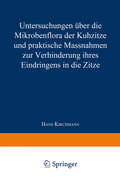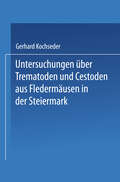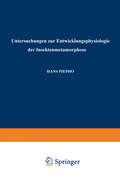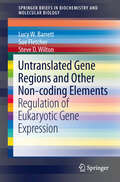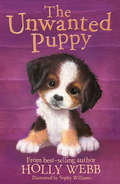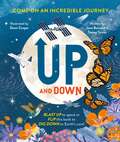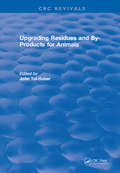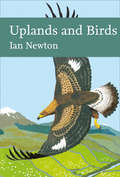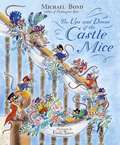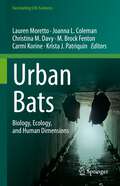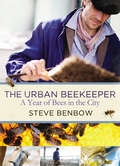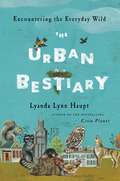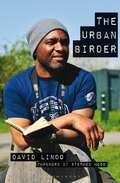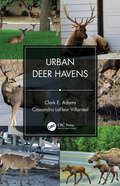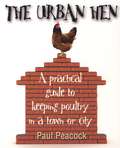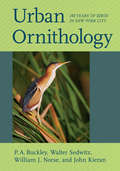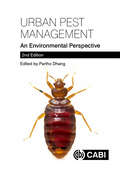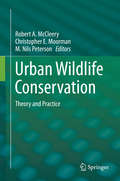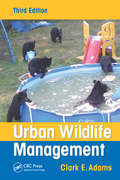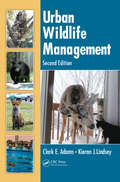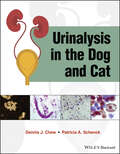- Table View
- List View
Untersuchungen über die Mikrobenflora der Kuhzitze und praktische Massnahmen zur Verhinderung ihres Eindringens in die Zitze
by Hans KirchmannDieser Buchtitel ist Teil des Digitalisierungsprojekts Springer Book Archives mit Publikationen, die seit den Anfängen des Verlags von 1842 erschienen sind. Der Verlag stellt mit diesem Archiv Quellen für die historische wie auch die disziplingeschichtliche Forschung zur Verfügung, die jeweils im historischen Kontext betrachtet werden müssen. Dieser Titel erschien in der Zeit vor 1945 und wird daher in seiner zeittypischen politisch-ideologischen Ausrichtung vom Verlag nicht beworben.
Untersuchungen über Trematoden und Cestoden aus Fledermäusen in der Steiermark (Sitzungsberichte der Österreichischen Akademie der Wissenschaften #8)
by Gerhard Kochseder1. In Microchiropteren der Steiermark wurden 17 Trematoden arten und 3 Cestodenarten gefunden. Die Trematoden gehören zur U. 0. Plagiorchiata, die Cestoden zur Familie Hymenolepididae. 2. Es werden die Ergebnisse mit den Befunden aus anderen europäischen Ländern verglichen. Für folgende Helminthen werden als neue Wirte angegeben: Für Prosthodendrium aelleni M yotis emarginatus und M yotis nattere1·i ; für Parabascus duboisi Rhinolophus ferrumequinum und Rhinolophus hipposideros; für Allassogonoporus amphoraefonnis Pipistrellus pipistrellus; für Retortosacculus trigonostoma Rhino lophus fe1·rumequinum; für Ophiosacculus meheleyi Pipistrellus pipistrell~tS. Für H ymenole11is grisea M yotis emarginatus und Barbastella barbastellus; für Hymenalepis balsaci Myotis myotis, Plecotus auritus und Rhinolophus ferrumequinum. 3. Eine Übersicht über den qualitativen Befall der einzelnen Wirtsarten sowie über die durch Vergesellschaftung der ver schiedenen Helminthen entstandenen Kombinationen wird gegeben. 4. Nach unseren Untersuchungen bestehen zwischen den ein zelnen Fledermausarten große Unterschiede in der Parasitenfauna, besonders im Befall durch Trematoden einerseits und Cestoden andererseits. Die Trematodenarten selbst weisen unterschiedliche Wirts spektra auf. Ökologische Einflüsse, besonders Unterschiede in der Nah rungswahl, scheinen für die Helminthenfauna eine bedeutende Rolle zu spielen. VII. Literaturverzeichnis BENEDEN VAN, P. J.: Los parasites des chauves·souris de Belgique. Mem. Acad. Roy. Belg., 40 (1873). CowARo, T. A.: Winter habits of the Greater Horseshoe (Rhinolophus ferrumcquinum SCBREBER) and other cave-haunting bats. Proc. Zool. Soc. London, 312-324 (1907). DANCAU, J. C.: Contributi Ia studiul helminthofo.unei chiropterelor din Romania. Lucr. Inst. speol. "Emil Racovito.", t.V., 81-89, Bucuresti (1966).
Untersuchungen zur Entwicklungsphysiologie der Insektenmetamorphose
by Hans PiephoDieser Buchtitel ist Teil des Digitalisierungsprojekts Springer Book Archives mit Publikationen, die seit den Anfängen des Verlags von 1842 erschienen sind. Der Verlag stellt mit diesem Archiv Quellen für die historische wie auch die disziplingeschichtliche Forschung zur Verfügung, die jeweils im historischen Kontext betrachtet werden müssen. Dieser Titel erschien in der Zeit vor 1945 und wird daher in seiner zeittypischen politisch-ideologischen Ausrichtung vom Verlag nicht beworben.
Untranslated Gene Regions and Other Non-coding Elements: Regulation of Eukaryotic Gene Expression (SpringerBriefs in Biochemistry and Molecular Biology)
by Lucy W. Barrett Sue Fletcher Steve D. WiltonThere is now compelling evidence that the complexity of higher organisms correlates with the relative amount of non-coding RNA rather than the number of protein-coding genes. Previously dismissed as “junk DNA”, it is the non-coding regions of the genome that are responsible for regulation, facilitating complex temporal and spatial gene expression through the combinatorial effect of numerous mechanisms and interactions working together to fine-tune gene expression. The major regions involved in regulation of a particular gene are the 5’ and 3’ untranslated regions and introns. In addition, pervasive transcription of complex genomes produces a variety of non-coding transcripts that interact with these regions and contribute to regulation. This book discusses recent insights into the regulatory roles of the untranslated gene regions and non-coding RNAs in the control of complex gene expression, as well as the implications of this in terms of organism complexity and evolution.
The Unwanted Puppy (Holly Webb Animal Stories #38)
by Holly WebbZoe loves dogs but hasn’t had one of her own since her beloved Honey died. Then Zoe spies Scout, a gorgeous Bernese Mountain puppy, in the park after school. Scout belongs to four-year-old Jack and his family, who are new to the neighbourhood. Zoe offers to walk Scout in the park as she’s worried the large, lively puppy isn’t getting enough exercise or attention. Gradually she falls in love with Scout – but she knows that Scout belongs to Jack, even if his family don’t have the time to give Scout the care he needs. How can she help Scout when he isn’t her dog to help?
Up and Down
by Tracey Turner Jane BurnardGo star-spotting, find out about cave-dwelling creatures, and discover a whole world of fascinating information in this gorgeously illustrated two-in-one book about the world.Read one way, Up and Down focuses on what’s up above us – clouds, stars, the Sun and Moon, things that fly. Flip the book and read it the other way to find out what’s down beneath our feet – burrowing animals, the Earth’s crust, fossils, caves, the Earth’s core.Colourful illustrations by Dawn Cooper bring a multitude of vivid scenes to life, from birds flying in bright blue skies to the inside of a volcano, while expert text from Jane Burnard engages the reader in learning all about the natural world.
Upgrading Residues and By-products for Animals
by J. Tal HuberAccumulation into one source of what is known regarding the feeding value of these materials and systems which have been developed for improving their digestibility, palatability or methods of handling was the motivation for organising this book. These has been an effort to include the major categories of unconventional materials which can potentially be upgraded to provide the ruminant with needed nutrients, but certainly some have been missed. It is hoped that this treatise will prove to be a valuable tool for workers involved in improving the utilization of residues and waste products for animals.
Upgrading Residues and By-products for Animals
by J. Tal HuberAccumulation into one source of what is known regarding the feeding value of these materials and systems which have been developed for improving their digestibility, palatability or methods of handling was the motivation for organising this book. These has been an effort to include the major categories of unconventional materials which can potentially be upgraded to provide the ruminant with needed nutrients, but certainly some have been missed. It is hoped that this treatise will prove to be a valuable tool for workers involved in improving the utilization of residues and waste products for animals.
Uplands and Birds (Collins New Naturalist Library)
by Ian NewtonIan Newton, author of Farming and Birds and Bird Migration returns to the New Naturalist series with a long awaited look at the uplands and its birds.
The Ups and Downs of the Castle Mice (The Castle Mice #2)
by Michael BondFrom the creator of Paddington Bear comes a tale of dastardly villains and unlikely tiny heroes...The Perk family live in a doll's house in a castle. The castle is their home - but when someone new with devious plans comes to rule the roost, will our family of mice come up trumps?Full of humour and warmth, this nostalgic tale by Michael Bond is brought to life with exquisite detail by Emily Sutton.
Upside-Down Dogs
by Serena Hodson'This charming little book captures man's best friend at its silliest: upside down. acked with laugh-out-loud photographs, it has every breed imaginable and is sure to warm even a cat lover's heart.' Katya Edwards, Daily MailCelebrated pet photographer Serena Hodson's silly, drooly, whimsical, and fun Upside-Down Dogs is sure to bring a smile to every dog lover's face. Her unique perspective brings these sweet, full-color photos to life on the page.Hodson takes beautiful colour photographs of humankind's best friend . . . but her furry subjects are always upside down. The results are stunning, charming, and laugh-out-loud adorable. No matter the breed, no matter the background, Hodson is able to capture the personality of each dog she works with. There's no better book to help someone turn their frown upside down.
Urban Bats: Biology, Ecology, and Human Dimensions (Fascinating Life Sciences)
by Lauren Moretto Joanna L. Coleman Christina M. Davy M. Brock Fenton Carmi Korine Krista J. PatriquinThe Anthropocene is the “age of human influence”, an epoch well known for its urban impact. More than half of all people already live in cities, and this proportion is expected to rise to almost 70 percent by 2050. Like other species in urban areas, bats must contend with the pressures of profound and irreversible land cover change and overcome certain unique challenges, such as the high density of roads, lights, glass, and free-ranging domestic animals. Research on urban bats in recent decades indicates that when it comes to urban life, some bats are synanthropes. In other words, although most species of bats are negatively impacted by urbanisation, many appear to not only succeed, but also thrive in cities and towns. This observation has inspired interesting questions about bats in relation to urbanisation. Which traits and behaviours equip bats for urban success? What features of urban areas increase the likelihood that bats will successfully persist there or even colonize new areas? And how does the success of urban bats affect co-habiting humans?Our book explores the interactions between bats and urban environments through case studies and reviews. Understanding how different species interact with urban environments can reveal potential opportunities to mitigate urban threats to bats and threats posed by bats to other urban organisms, including humans. With this book, we thus aspire to provide a knowledge base to help guide current and future efforts to conserve bats.
The Urban Beekeeper: A Year of Bees in the City
by Steve BenbowAt a time when the UK bee population is in decline there's no better way to make a difference than to start up your own beehive. Steve Benbow's enormous success with urban beekeeping show's how easy it is to keep bees, whether you're in the city or in the countryside, a beginner or an experienced beekeeper, and you'll never look back once you've tasted your very own sticky, golden honey, or lit a candle made from the beeswax from your beehive.Steve Benbow is a visionary beekeeper who started his first beehive ten years ago on the roof of his tower block in Bermondsey and today runs 30 sites across the city. His bees live atop the Tate Modern and Tate Britain, Fortnum & Mason and the National Portrait Gallery, and he supplies honey to the Savoy tearooms, Harvey Nichols, Harrods and delis across London. His bees forage in parks, cemeteries, along railway lines and in window boxes, and because of the diversity of the plants and trees in the city, produce far richer honey and greater yields than they would in rural areas.The Urban Beekeeper is a fact-filled diary and practical guide to beekeeping that follows a year in the life of Steve and his bees and shows how keeping bees and making your own delicious honey is something anyone can do. It is a tempting glimpse into a sunlit lifestyle that starts with the first rays of the morning and ends with the warm glow of sunset, filled with oozing honeycomb, recipes for sensational honey-based dishes, and honey that tastes like sunshine. A hugely affectionate but practical diary of a beekeeper's year and the immense satisfaction of harvesting your own delicious honey. Read it and join the revolution.
The Urban Bestiary: Encountering the Everyday Wild
by Lyanda Lynn HauptFrom the bestselling author of Crow Planet, a compelling journey into the secret lives of the wild animals at our back door. In The Urban Bestiary, acclaimed nature writer Lyanda Lynn Haupt journeys into the heart of the everyday wild, where coyotes, raccoons, chickens, hawks, and humans live in closer proximity than ever before. Haupt's observations bring compelling new questions to light: Whose "home" is this? Where does the wild end and the city begin? And what difference does it make to us as humans living our everyday lives? In this wholly original blend of science, story, myth, and memoir, Haupt draws us into the secret world of the wild creatures that dwell among us in our urban neighborhoods, whether we are aware of them or not. With beautiful illustrations and practical sidebars on everything from animal tracking to opossum removal, The Urban Bestiary is a lyrical book that awakens wonder, delight, and respect for the urban wild, and our place within it.
The Urban Birder
by David LindoAnyone can become an Urban Birder. You can do it anywhere and any time, whether you've got the day to spare, on your way to work, during your lunch break or just looking out of a window. Look up and you will see.The book is an inspirational look at the birdlife in our cities, or more accurately, the author's personal journey of discovery involving encounters with racism, air rifle-toting youths, girls, alcohol, music, finding urban wildlife oases and of course, birds.David Lindo's story is entertaining and sometimes controversial, but the one guarantee is that the reader will be left feeling inspired enough to pick up a pair of binoculars and head to the nearest park.
Urban Deer Havens
by Clark E. Adams Cassandra LaFleur VillarrealUrban Deer Havens consists of a thorough examination of selected cervid (deer) species that are known to inhabit urban communities in the United States. The deer species that are included in this presentation consisted of white-tailed (Odocoileus virginianus), Key deer (O. v. clavium), moose (Alces alces), elk (Cervus elaphus), mule (Odocoileus hemionus), and black-tailed deer (O. h. columbianus). This book is the first attempt to examine the similarities and differences in those factors that allow the selected cervids to exist and thrive in urban habitats. This information has never been collected, collated, reviewed, and published under one cover document. Yet, all five are known to inhabit urban communities within their geographic range. The lack of information concerning several important examples of urban cervids in conjunction with a proliferation of information on white-tailed deer only is an incomplete and biased presentation. This book is the first comprehensive source of information on urban deer management, which includes a broad assemblage of urban cervids. The overall objective of this book is to provide a more holistic examination of urban cervids. For example, it examines the similarities and differences of the environmental impacts, management strategies, and human dimensions considerations concerning urban cervids in general, and using specific examples. Urban Deer Havens features four chapters that include: Urban deer census techniques and population dynamics Comprehensive tables that review urban community deer management plans National and state-wide estimates the five selected cervids Laws and regulations concerning urban deer Lethal and nonlethal management options for managing deer Steps for managing urban deer populations Examples of urban deer management efforts
Urban Deer Havens
by Clark E. Adams Cassandra LaFleur VillarrealUrban Deer Havens consists of a thorough examination of selected cervid (deer) species that are known to inhabit urban communities in the United States. The deer species that are included in this presentation consisted of white-tailed (Odocoileus virginianus), Key deer (O. v. clavium), moose (Alces alces), elk (Cervus elaphus), mule (Odocoileus hemionus), and black-tailed deer (O. h. columbianus). This book is the first attempt to examine the similarities and differences in those factors that allow the selected cervids to exist and thrive in urban habitats. This information has never been collected, collated, reviewed, and published under one cover document. Yet, all five are known to inhabit urban communities within their geographic range. The lack of information concerning several important examples of urban cervids in conjunction with a proliferation of information on white-tailed deer only is an incomplete and biased presentation. This book is the first comprehensive source of information on urban deer management, which includes a broad assemblage of urban cervids. The overall objective of this book is to provide a more holistic examination of urban cervids. For example, it examines the similarities and differences of the environmental impacts, management strategies, and human dimensions considerations concerning urban cervids in general, and using specific examples. Urban Deer Havens features four chapters that include: Urban deer census techniques and population dynamics Comprehensive tables that review urban community deer management plans National and state-wide estimates the five selected cervids Laws and regulations concerning urban deer Lethal and nonlethal management options for managing deer Steps for managing urban deer populations Examples of urban deer management efforts
The Urban Hen: A practical guide to keeping poultry in a town or city
by Paul Peacock"The Urban Hen" is the perfect companion for the city poultry keeper and shows you how to maintain a happy, healthy garden or backyard flock in towns and cities. Paul Peacock shows you how to: find the best poultry for the small garden and house them properly, feed your birds, tune in to their daily needs and enjoy your own eggs; avoid annoying the neighbours by showing that it is possible to keep poultry without attracting unwelcome pests; recognise healthy happy birds and learn their daily routine; recognise poorly hens; treat them or get help; and, incubate and care for fertilised eggs and raise chicks.
Urban Ornithology: 150 Years of Birds in New York City
by P. A. Buckley Walter Sedwitz William J. Norse John KieranUrban Ornithology is the first quantitative historical analysis of any New York City natural area’s birdlife and spans the century and a half from 1872 to 2016. Only Manhattan’s Central and Brooklyn’s Prospect Parks have preliminary species lists, not revised since 1967, and the last book examining the birdlife of the entire New York City area is now more than fifty years old.This book updates the avifaunas of those two parks, the Bronx, and other New York City boroughs. It treats the 301 bird species known to have occurred within its study area—Van Cortlandt Park and the adjacent Northwest Bronx—plus 70 potential additions. Its 123 breeding species are tracked from 1872 and supplemented by quantitative breeding bird censuses from 1937 to 2015. Gains and losses of breeding species are discussed in light of an expanding New York City inexorably extinguishing unique habitats.
Urban Pest Management: An Environmental Perspective
by Edited by Partho DhangThe management and control of pests in the urban environment in the 21st Century faces many challenges. Pest populations adapt to changing conditions brought about by environmental changes caused by global warming, human population growth, and increased pollution. Urban pests are able to expand their ranges, densities, and habitats, sometimes causing large-scale damage and disease. This book provides collective insights from academic and industry experts on perspectives concerning urban pest management and regulatory innovations arising from the rapid onset of recent environmental challenges. Chapter topics address pest biology, advances in urban pest management practices, emerging urban pest control developments, new technologies, and regulations. The book describes new methods of pest control, their impacts on human health and the environment, and strategies for integrated management limiting the use of chemicals. It provides a practical resource for researchers and policy makers in pest management, urban health, medical entomology and environmental science. This title provides: An up-to-date and comprehensive resource on environmental urban pest management. A resource designed to appeal to pest control operators, public health professionals, and a range of field workers, as well as researching academics and graduate students. Insights from both academic and industry experts together in one volume.
Urban Wildlife Conservation: Theory and Practice
by Robert A. McCleery Christopher E. Moorman M. Nils PetersonIn the past, wildlife living in urban areas were ignored by wildlife professionals and urban planners because cities were perceived as places for people and not for wild animals. Paradoxically, though, many species of wildlife thrive in these built environments. Interactions between humans and wildlife are more frequent in urban areas than any other place on earth and these interactions impact human health, safety and welfare in both positive and negative ways. Although urban wildlife control pest species, pollinate plants and are fun to watch, they also damage property, spread disease and even attack people and pets. In urban areas, the combination of dense human populations, buildings, impermeable surfaces, introduced vegetation, and high concentrations of food, water and pollution alter wildlife populations and communities in ways unseen in more natural environments. For these ecological and practical reasons, researchers and mangers have shown a growing interest in urban wildlife ecology and management.This growing interest in urban wildlife has inspired many studies on the subject that have yet to be synthesized in a cohesive narrative. Urban Wildlife: Theory and Practice fills this void by synthesizing the latest ecological and social knowledge in the subject area into an interdisciplinary and practical text. This volume provides a foundation for the future growth and understanding of urban wildlife ecology and management by:• Clearly defining the concepts used to study and describe urban wildlife,• Offering a cohesive understanding of the coupled natural and social drivers that shape urban wildlife ecology,• Presenting the patterns and processes of wildlife response to an urbanizing world and explaining the mechanisms behind them and• Proposing means to create physical and social environments that are mutually beneficial for both humans and wildlife.
Urban Wildlife Management
by Clark E. AdamsWinner of the 2018 TWS Wildlife Publication Awards in the authored book category Urban development is one of the leading worldwide threats to conserving biodiversity. In the near future, wildlife management in urban landscapes will be a prominent issue for wildlife professionals. This new edition of Urban Wildlife Management continues the work of its predecessors by providing a comprehensive examination of the issues that increase the need for urban wildlife management, exploring the changing dynamics of the field while giving historical perspectives and looking at current trends and future directions. The book examines a range of topics on human interactions with wildlife in urbanized environments. It focuses not only on ecological matters but also on political, economic, and societal issues that must be addressed for successful management planning. This edition features an entirely new section on urban wildlife species, including chapters on urban communities, herpetofauna, birds, ungulates, mammals, carnivores, and feral and introduced species. The third edition features Five new chapters 12 updated chapters Four new case studies Seven new appendices and species profiles 90 new figures A comprehensive analysis of terrestrial vertebrate locations by state and urban observations Each chapter opens with a set of key concepts which are then examined in the following discussions. Suggested learning experiences to enhance knowledge conclude each chapter. The species profiles cover not only data about the animal concerned but also detail significant current management issues related to the species. An updated and expanded teaching tool, Urban Wildlife Management, Third Edition identifies the challenges and opportunities facing wildlife in urban communities as well as factors that promote or threaten their presence. It gives both students and professionals a solid grounding in the required fundamental ecological principles for understanding the effects of human-made environments on wildlife.
Urban Wildlife Management
by Clark E. AdamsWinner of the 2018 TWS Wildlife Publication Awards in the authored book category Urban development is one of the leading worldwide threats to conserving biodiversity. In the near future, wildlife management in urban landscapes will be a prominent issue for wildlife professionals. This new edition of Urban Wildlife Management continues the work of its predecessors by providing a comprehensive examination of the issues that increase the need for urban wildlife management, exploring the changing dynamics of the field while giving historical perspectives and looking at current trends and future directions. The book examines a range of topics on human interactions with wildlife in urbanized environments. It focuses not only on ecological matters but also on political, economic, and societal issues that must be addressed for successful management planning. This edition features an entirely new section on urban wildlife species, including chapters on urban communities, herpetofauna, birds, ungulates, mammals, carnivores, and feral and introduced species. The third edition features Five new chapters 12 updated chapters Four new case studies Seven new appendices and species profiles 90 new figures A comprehensive analysis of terrestrial vertebrate locations by state and urban observations Each chapter opens with a set of key concepts which are then examined in the following discussions. Suggested learning experiences to enhance knowledge conclude each chapter. The species profiles cover not only data about the animal concerned but also detail significant current management issues related to the species. An updated and expanded teaching tool, Urban Wildlife Management, Third Edition identifies the challenges and opportunities facing wildlife in urban communities as well as factors that promote or threaten their presence. It gives both students and professionals a solid grounding in the required fundamental ecological principles for understanding the effects of human-made environments on wildlife.
Urban Wildlife Management
by Clark E. Adams Kieran J. LindseyWhen the first edition of Urban Wildlife Management was published two years ago, it provided conservationists, ecologists, and wildlife professionals with a welcome shift in the way that interactions between humans and wildlife were viewed and managed. Instead of focusing on ways to evict or eradicate wildlife encroached on by urban development, th
Urinalysis in the Dog and Cat
by Dennis J. Chew Patricia A. SchenckUrinalysis in the Dog and Cat A comprehensive up to date textbook for performing and interpreting urinalysis in dogs and cats with content that remains accessible to those in primary care and specialty practices. In Urinalysis in the Dog and Cat, a logical sequence to collection of urine, performing the complete urinalysis (physical and chemical properties along with urinary sediment microscopy), and interpretation of results is presented. The FAQ chapter and the chapter on urinalysis case examples provide easily accessible information for primary care veterinarians and technicians as well as veterinary students. Each didactic chapter is designed to provide basic information first and then more advanced materials deeper into each chapter. Some materials will also be useful to specialists and those in advanced training. An extensive review of proteinuria is included as a separate chapter. Automated urine chemistry by dipstrip and automated urinary sediment microscopy are discussed in some detail as this technology increasingly will be incorporated in veterinary laboratory practice. The text is accompanied by hundreds of high-quality photographs and medical illustrations that highlight common and rare findings from the urine of dogs and cats. Numerous algorithms suggest possible pathways for the diagnosis and treatment of urinary disorders. This book is destined to be widely used in veterinary hospitals by seasoned and young attending veterinarians seeking to know more about urinalysis, as well as by veterinary laboratory technicians. Several sections of this book will be useful in the teaching of basic concepts to veterinary students. The authors have also included: An introduction to the philosophy of urinalysis and the detailed information about collection of urine from dogs and cats. Comprehensive explorations of urine sample handling, preparation, and analysis. Detailed aspects of USG as the most important physical property of canine and feline urine In-depth discussions of urine chemistry dipstrip evaluation for pH, protein, occult blood, glucose, ketones, and bilirubin. Extensive detailing of urinary sediment microscopy. Sections on FAQ and urinalysis case examples allow the reader to test their knowledge about urinalysis. Urinalysis in the Dog and Cat is an essential reference for primary care veterinarians, veterinary technicians, veterinary students, those in advanced training programs, and specialists interested in learning more about disorders of the urinary tract.
